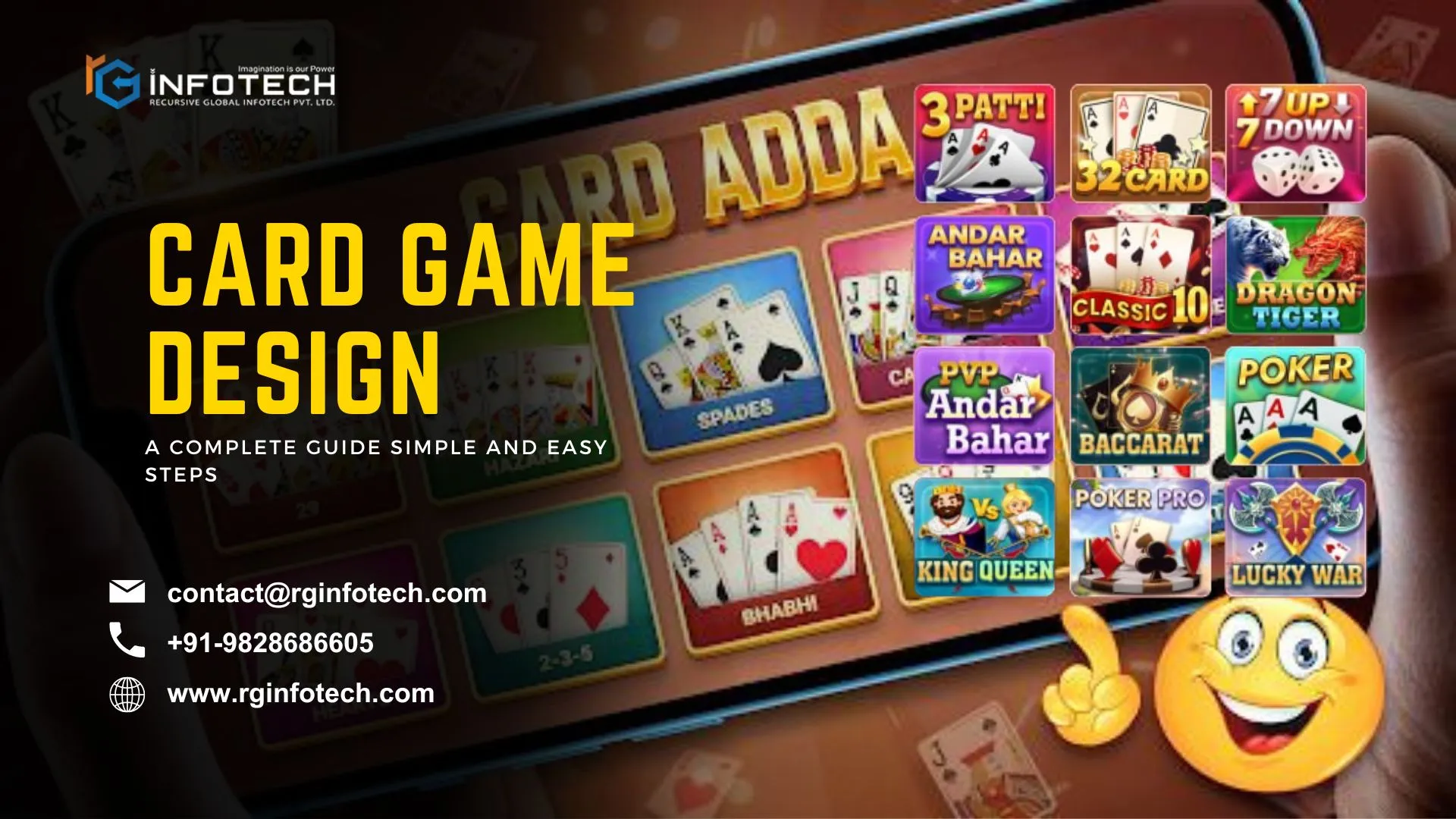A Complete Guide to Simple and Easy Card Game Design

Card games have always been people’s favorite way to pass time, dating back to the medieval era. But now its popularity has reached new heights, marked by the diverse iterations of classic games like Go Fish that persist today. Developing a game app through a proven formula is a reliable and true method. Just like any other video game and other forms of interactive media, card games have evolved and advanced over time. Card game design ideas have evolved from a simple game of solitaire to a complex game like magic and gathering.
Amidst these beloved favorites, enthusiasts continually craft unique and innovative card games, perpetuating the evolution. Amidst these beloved favorites, people always strive to create more innovative and unique games, perpetuating the evolution and popularity of this timeless and classic form of entertainment. Design is the backbone of any successful card game, dictating its mechanics, balance, and overall appeal. A well-developed card game engages players by providing intuitive rules, strategic depth, and meaningful choices.
These card games are highly accessible, with clear instructions and mechanics ensuring players can easily and quickly grasp the games intricacies. Maintaining balance is necessary to prevent the dominance of any single strategy in a dynamic and competitive environment. Theme and artwork can further enhance immersion, drawing players into well-crafted worlds. In essence, design is the foundation of engaging and enduring card games, captivating players, and fostering communities of card game fanatics.
11 Easy Steps to Consider in The Card Game Designing Process
When considering the development of a mobile game of any magnitude, it is crucial to consider the critical aspects related to the background of the game. Whether it’s simple card game design or complex game design, once you understand what makes a game fun, understanding the process will become a lot easier for you. The more you experiment with new designs, the better your designs will get. Here are some easy steps to design a card game app that you need to consider:
Understanding Game Mechanics
You need to understand the mechanics of the game to design the best card game that is both appealing and engaging. Game mechanics encompass the rules and systems governing player actions, resource management, interaction, and win conditions. Core mechanics, like drawing the playing cards, set the foundation, while player actions push gameplay forward, offering strategic choices and opportunities for interaction. Resource management adds depth, requiring players to balance their resources to achieve goals. Interaction mechanics promote engagement and social dynamics among players, while randomness and luck add unpredictability.
Defining Game Objectives
One of the most important steps to designing a card game online is defining the objectives of players, as it shapes the mechanics and overall gameplay experience. Players may strive to complete tasks or defeat opponents, and these objectives greatly influence the mechanics of the game. For instance, in a racing game, the mechanics will center around movement and speed, with the players striving to advance rapidly toward a goal. Conversely, in a strategy game, mechanics may prioritize resource management and area control, allowing players to allocate resources strategically and compete for dominance over territory.
Theme Development and Art Style
According to a top card game designer online, theme development and art style play an important part in the process of card game design, contributing to the game’s immersion, aesthetic appeal, and overall gaming experience.
-
-
-
- Theme Development: Creating an appealing and captivating theme is crucial for coherence and engagement. The theme sets the tone, atmosphere, and narrative context, attracting players into the realm of online gaming. Consider the audience preferences and themes that blend with the mechanics. Whether exploring fantastical realms, historical events, or epic adventures, a well-developed theme enhances the gaming experience.
- Art Style: According to the top designers of a reputable card game development company, this aspect is equally important as theme development, gaining attention for enhancing aesthetic appeal. Art style should complement the theme, reinforcing the narrative and immersing players. Whether vibrant and whimsical for family-friendly games, intricate for fantasy worlds, or gritty for post-apocalyptic. Collaborating with skilled artists brings visions to life, creating visuals that players find relatable.
-
-
With the help of meticulously developed themes and art styles, developers offer card game design services to create visually stunning, thematically rich card games that captivate players and engage them for a long time.
Designing Cards: Types, Abilities, and Balance
Designing cards for a game involves creating various types with distinct abilities while maintaining balance. Cards can turn into characters, items, spells, and event types, each contributing uniquely to gameplay. Designing card games involves three key aspects that you need to consider: types, abilities, and balance. Let’s explore these aspects:
-
-
-
- Types: You can categorize cards into various types, such as character, spell, and event cards. Character cards typically represent units or creatures; spell cards introduce magical effects or abilities; item cards offer equipment or artifacts; and event cards create temporary or permanent changes to gameplay dynamics.
- Abilities: Each card possesses unique abilities that add depth to the gameplay and strategy, like impressive card game UI design and themes. These abilities can range from passive traits that are always active and have triggering effects that require players input or react to specific game events. Additionally, static abilities continuously influence the game state, shaping the interactions and decisions of the players.
- Balance: Achieving balance across cards is crucial to ensuring a fair and enjoyable gaming experience. Our card game development software allows the maintenance of the balance of cards in terms of their power level relative to other cards, their resource cost, and their interactions with other elements of the game. Rigorous playtesting is essential to identify any imbalances, overpowered combinations, or under-visualized cards, allowing designers to refine card designs and abilities accordingly.
-
-
Creating a Rulebook
The rulebook is an essential card game design tool for players to understand the intricacies and strategies of the game. Emphasizing its role as a guide underscores the importance of familiarizing yourself with its contents to fully engage with the gaming experience and maximize enjoyment. Mastery of the rulebook unlocks the true potential of the game, allowing players to make better decisions and dive deeper into this matter with confidence.
Besides providing clarity on the game’s mechanics and strategies, rulebooks also serve as a reference point for resolving disputes or clarifying ambiguities during gameplay; they act as a foundational document that sets the framework for how to play the game, ensuring consistency and fairness across different gaming sessions.
Moreover, a well-developed rulebook can increase the user experience by providing information in a clear, understandable, organized, and visually appealing manner. It may include illustrations, diagrams, or examples to help comprehension and make learning the game more seamless and accessible, especially for new players.
Prototyping and Playtesting
Creating a prototype and thoroughly testing it is among the crucial steps in the process of game development. Creating a prototype helps you evaluate the rules, functionalities, mechanics, and other important aspects before investing significant resources into mass production. By testing the prototype with both friends and unbiased parties of diverse backgrounds, games, and experience levels. You can collect valuable reviews and feedback and identify any flaws or areas that need improvement.
Creating a fully functional prototype and testing it with real people is essential to ensuring the success of your game. This method allows you to improve the mechanics of the game, balance, and overall experience. To find playtesters, consider leveraging popular gaming forums or dedicated playtesting platforms. By soliciting feedback from individuals of varying backgrounds and gaming expertise, you can identify areas for improvement and enhance the game’s appeal to a wide audience.
Iterative Design Process
This design process involves a cyclical approach to game development. Here, each iteration refines and improves the game depending on feedback and testing. It typically consists of several key stages: concept development, prototyping, playtesting, feedback analysis, and iteration. In this process, designers continuously refine and iterate upon the card game design software, the game’s mechanics, rules, and features to enhance its overall quality and player experience. The flexibility and adaptation ability of this approach ensures that the final product meets the needs and expectations of its audience.
Graphic Design and Layout
Crafting your trading card game design begins with selecting the right graphic design software, enabling you to work with layers and groups seamlessly. Can improve the gaming experience of players, keeping them engaged with the game’s world and mechanics. As you dive into designing the layout for the front face of your cards, consider the nature of your game. If it’s an original creation, embrace the freedom to explore endless possibilities in card design.
Let your creativity shine as you infuse each card with unique themes, artwork, and mechanics, creating a captivating gaming experience. For trading cards, draw inspiration from established layout conventions, such as those found in Magic: The Gathering. With the help of card game creation software, you can incorporate familiar elements like character portraits, stats, and flavor text, arranged in a format that players will instantly recognize and appreciate. Strive for clarity and visual appeal to enhance gameplay immersion.
Printing and Production Considerations
When preparing your card game for printing and production, several key factors, like choosing the best trading card game design software and tools, demand attention to ensure a successful outcome. But first and foremost, the choice of printing method, whether digital or offset, should align with your production needs and budget constraints. Equally critical is the selection of card stock and finish to achieve the desired aesthetic and durability.
Thoughtful packaging design not only protects the cards but also enhances the game’s presentation and marketability. Attention to detail in component quality and artwork specifications ensures that the final product meets your standards. Consideration of quantity, cost optimization, and shipping logistics completes the preparation process, ensuring a seamless transition from design to production.
Marketing and Distribution Strategies
Crafting effective marketing and distribution strategies is crucial for the successful launch and promotion of your card game. It starts by understanding the interests of your target audience and modifying your strategies to suit their preferences. Establishing a compelling brand identity through captivating visuals, messaging, and storytelling helps differentiate your game in a crowded market.
Utilize online platforms such as websites and social media channels to engage with potential players, share updates, and build anticipation. Collaborating with influencers and attending gaming events can broaden your reach and credibility within the gaming community. Offering demo versions, tutorials, and incentives like limited edition cards can further entice players to try your game.
Securing distribution channels, both traditional and digital, ensures broad availability and accessibility for players. Collecting and leveraging player feedback allows for continuous improvement and refinement of your strategies over time. By adopting a proactive and adaptable approach, you can effectively market and distribute your card game to a wider audience, driving engagement and fostering long-term success.
Launching and Post-Launch Support
Launching your card game is just the beginning; post-launch support is equally vital for maintaining player engagement and sustaining momentum. Promptly address technical issues, bugs, and player inquiries to ensure a positive experience. Use social media platforms to promote your app by engaging with the community, asking for feedback, and monitoring feedback and analytics to inform updates and expansions, keeping the game fresh and appealing.
Being transparent and adaptable are the crucial card game design solutions that let you communicate openly with players and evolve the game based on their input and market trends. By providing exceptional post-launch support, engaging with your community, and continuously improving your game, you can maximize its potential for success and longevity in the competitive gaming industry.
Conclusion
The above-provided details and information discuss the simple steps of designing a card game, from concept development to post-launch support. By following these steps, aspiring game designers can create engaging and memorable card games that captivate players and stand out in the market. With dedication, creativity, and attention to detail, designers can bring their card game ideas to life and share them with players around the world. Stay tuned for more updates.
Frequently Asked Questions (FAQs)
Creating compelling social and community elements, preventing cheating or exploitation, implementing efficient matchmaking and multiplayer features, and guaranteeing fluid gameplay across various devices and internet connections are just a few of the problems that come with designing for online play.
A well-designed online card game should have an easy-to-use interface and controls, strong matchmaking and multiplayer capabilities, thorough tutorials and onboarding procedures for new players, regular content releases to keep the game interesting, and active community involvement through events, tournaments, and social features.
To translate a physical card game idea to an online format, consider factors such as adapting gameplay mechanics for digital play, designing user-friendly interfaces optimized for various devices, implementing online multiplayer and matchmaking features, integrating social and community features, and ensuring data security and fair play measures.
To ensure your card game stands out in a saturated market, it’s essential to implement a multi-faceted approach that addresses various aspects of game development and marketing. First and foremost, prioritize creating a unique and compelling gameplay experience that captivates players and sets your game apart from the competition. This may involve innovative mechanics, immersive storytelling, or distinctive themes that resonate with your target audience.
The development process of a card game typically involves concept development, prototyping, playtesting, iteration and refinement, graphic design and artwork creation, rulebook writing, production and printing, marketing and distribution, and post-launch support and updates.
Playtesting is crucial in the card game development process as it helps identify and address various aspects of the game, including mechanics, balance, rules, and overall enjoyment. By playtesting with a diverse group of players, developers can gather valuable feedback, identify potential issues or imbalances, and make necessary adjustments to improve the game’s quality and playability.
Balancing a card game involves iterative design, clear goal-setting, data analysis, variable adjustments, and meta-game monitoring. Through these strategies, developers refine the game’s balance, ensuring a fair and engaging experience for all players.
To make your card game accessible to new players:
-
-
-
- Provide clear rules. Ensure rules are concise and easy to understand, using examples and illustrations to clarify mechanics.
- Supportive community: Foster a welcoming environment where players can ask questions and receive guidance from experienced players.
- Gradual complexity: Introduce mechanics slowly, allowing players to learn at their own pace.
- Beginner-friendly content: Include starter decks, tutorials, and guided gameplay to help new players get started.
-
-



 rgisales
rgisales



